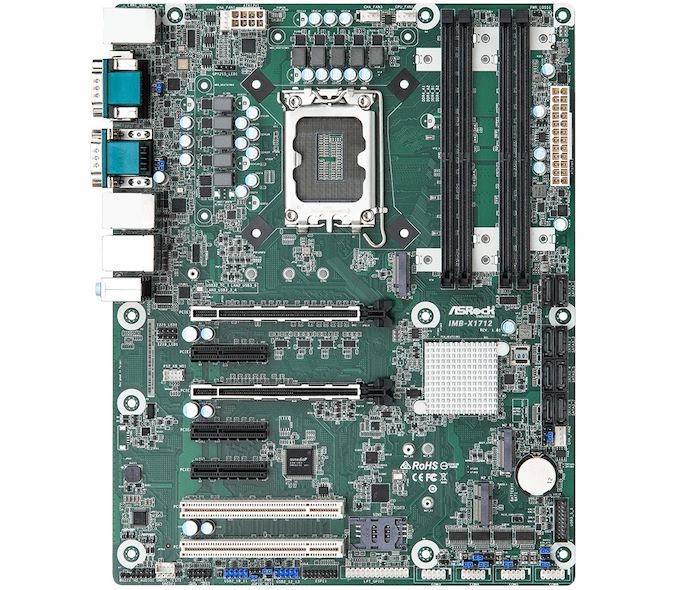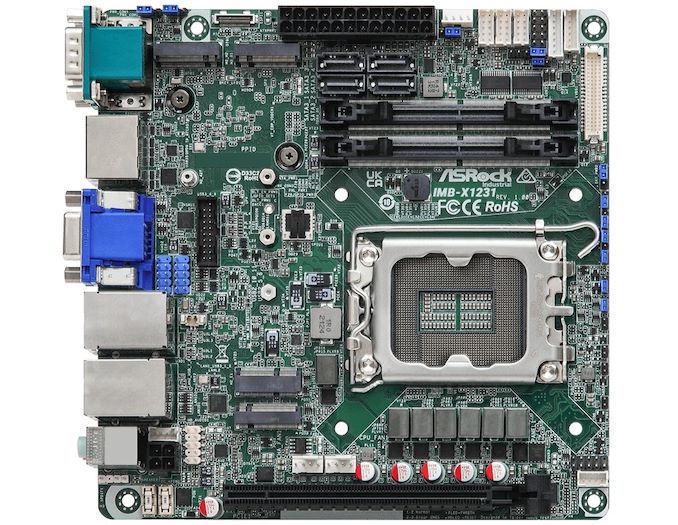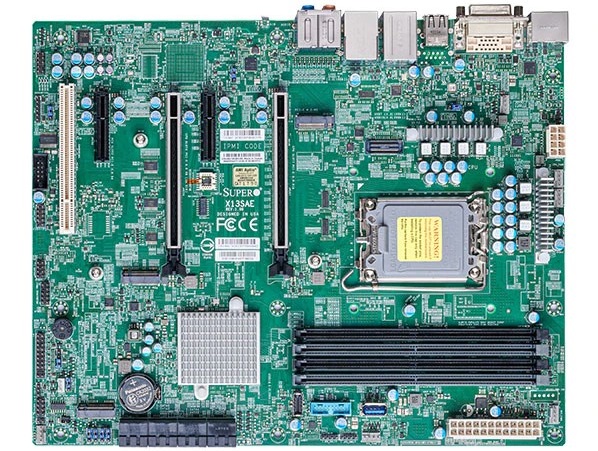The Intel W680 Chipset Overview: Alder Lake Workstations Get ECC Memory and Overclocking Support
by Gavin Bonshor on March 9, 2022 4:00 PM EST_678x452.jpg)
Earlier this month Intel quietly launched its W680 chipset, the company's workstation-focused chipset for its 12th Gen Core (Alder Lake) processors. Unlike the current generation of consumer desktop chipsets such as Z690, H670, B660, and H610, the W680 adds the capability to use ECC DRAM, including both DDR5 and DDR4 variants. At present, there haven't been many W680 motherboard announcements, although a couple of vendors, including ASRock Industrial and Supermicro have a few options listed. So we're giving you the lowdown on W680, what it has to offer, and what technologies it brings for users looking to build a workstation-class desktop with Intel's latest Alder Lake architecture.
The Intel W680 Chipset: Enabling Alder Lake Workstations
Typically when Intel launches a new series of processors for the desktop market, it releases multiple chipsets with varying levels of features. For its 12th Gen Core family, Intel initially launched its CPUs and premium Z690 chipset, and followed that up with its more affordable H660, B660, and H610 chipsets. In most generations the product stack is rounded out a bit later with a W-series workstation-focused chipset, and finally a variety of Xeon-E series.
Enter the Intel W680 chipset, which is Intel's designated workstation chipset for its 12th Gen Core platform. The Intel W680 chipset is interesting for a variety of reasons, not the least of which is that that it formally opens up ECC memory support for Intel's Alder Lake-S desktop processors.

Intel W680 Chipset Block Diagram
Some of the main features of the W680 chipset include a PCIe 4.0 x8 DMI link, which connects the processor to the chipset for improved bandwidth over Intel's previous W-series chipsets. Other features include support for up to eight SATA ports and integrated Wi-Fi 6E PHY/2.5 GbE MACs for vendors to hook in the latest networking controllers. Intel includes support for 16x PCIe 5.0 lanes from the CPU, with the usual 16/0 or 8/8 bifurcation options.
| Intel W680, Z690, W580, and W480 Chipset Comparison | ||||
| Feature | W680 | Z690 | W580 | W480 |
| Socket | LGA1700 | LGA1700 | LGA1200 | LGA1200 |
| uArch | Alder Lake | Alder Lake | Rocket Lake | Comet Lake |
| PCIe Lanes (CPU) | 16 x 5.0 4 x 4.0 |
16 x 5.0 4 x 4.0 |
20 x 4.0 | 16 x 3.0 |
| PCIe Lanes (Chipset) | 12 x 4.0 16 x 3.0 |
12 x 4.0 16 x 3.0 |
24 x 3.0 | 24 x 3.0 |
| PCIe Specification (CPU) | 5.0/4.0 | 5.0/4.0 | 3.0 | 3.0 |
| Memory Support | DDR5-4800B DDR4-3200 |
DDR5-4800B DDR4-3200 |
DDR4-2933 | DDR4-2933 |
| ECC Memory | Y | N | Y | Y |
| DMI Lanes | x8 4.0 | x8 4.0 | N/A | N/A |
| Max USB 3.2 (Gen2/Gen1) | 10/10 | 10/10 | 6/10 | 6/10 |
| USB 3.2 Gen 2x2 (20 Gbps) | Y | Y | ASMedia | ASMedia |
| Total USB | 14 | 14 | 14 | 14 |
| Max SATA Ports | 8 | 8 | 8 | 8 |
| Memory Channels (Dual) | 2/2 | 2/2 | 2/2 | 2/2 |
| Intel Optane Memory Support | Y | Y | Y | Y |
| Intel Rapid Storage Tech (RST) | Y | Y | Y | Y |
| Integrated Wi-Fi MAC | Wi-Fi 6E | Wi-Fi 6E | Wi-Fi 6 | Wi-Fi 6 |
| Intel Smart Sound | Y | Y | Y | Y |
| Overclocking Support | Y | Y | N | N |
| Intel vPro | Y | N | Y | Y |
| ME Firmware | 16 | 16 | 15 | 14 |
| TDP (W) | 6 | 6 | 6 | 6 |
Other features with W680 include native support for USB 3.2 Gen2x2 (20 Gbps) Type-C connectivity. However, most of the cost and implementation of networking and connectivity still rely on vendors using solutions through proprietary CNVi connections. This is much the same story on regular Z690, H670, B660, and H610 options, the cost for the target market is a massive factor here on what vendors decide to include or omit. The point is the capability is there should a vendor wish to utilize it.
Intel W680: Now with Official Overclocking Support for CPU & Memory
On the whole, there isn't much difference between the W680 and Z690 chipsets when comparing technical specifications. This includes package size (both are 28 x 25 mm), USB, PCIe, and storage support, but interestingly there's a new addition to Intel's latest desktop workstation chipset. This 'new' inclusion is official support for overclocking, which is something both of the previous W-series chipsets – W580 and W480 – omitted.
While the last couple of W-series chipsets allowed users to overclock the memory on supported processors, Intel has opened this up to unlocking the core frequency when combined with its K-series processors on W680. And while this functionality is appreciated, it's admittedly unlikely users will want to significantly overclock an already hot running and high-powered Alder Lake processor, especially on a motherboard that doesn't have a robust power delivery system like Z690 motherboards do.
The point to this is Intel is giving users a choice, and while it sounds nonsensical in practice, it's a pretty big move for conservative Intel. It should be noted that its H610 chipset doesn't support CPU overclocking; it's an interesting shift from Intel's previous standpoint when it comes to overclocking.
W680 Motherboards: What's Currently Announced (As of March 9th)
Despite Intel opting for a slow ramp up for its W680 chipset, a few motherboard options are officially listed, including from ASRock Industrial and Supermicro. As time goes by, and perhaps when Intel pulls the trigger on its obligatory Xeon E-3300 family of processors, motherboard vendors might opt to officially announce more models.
The key element with W680 is that while they offer support for existing Alder Lake-S processors, they are designed around its Xeon series, which aren't usually overclockable. These models generally feature lower core frequencies and TDPs, given their greater focus on reliability versus performance.
ASRock Industrial W680
As it stands, ASRock Industrial has four W680 motherboards listed at the time of writing. This includes one thin-ITX model (IMB-X1233-WV), one mini-ITX model (IMB-X1231), one micro-ATX model (IMB-X1314) and one full-sized ATX model (IMB-X1712).

The ASRock Industrial IMB-X1712 ATX (W680) motherboard.
All of ASRock Industrial's W680 options include support for ECC DDR4-3200 memory and offer varying levels of PCIe 4.0 and storage support. The PCIe 4.0 support depends on the form factor as the ITX sized offerings are limited to just one full-length PCIe 4.0 slot, while the IMB-X1314 and IMB-X1712 have two full-length PCIe 4.0 slots available. For the ITX sized models, both benefit from dual 2.5 GbE, while the larger models have three 2.5 GbE controllers, all of which use Intel I225-LM controllers to power each Ethernet port across all models. It's worth noting that the IMB-X1712 includes two PCI slots for legacy devices.

The ASRock Industrial IMB-X1231 mini-ITX (W680) motherboard.
Both the IMB-X1233-WV and IMB-X1231 ITX sized offerings allow support for Alder Lake-S processors with a maximum TDP of 65 W, while the micro-ATX IMB-X1314 and ATX IMB-X1712 enable users to use processors with a base TDP of up to 125 W. Support and compatibility here are aligned and determined by the base frequency TDP rating on these models.
At the time of writing, ASRock Industrial hasn't announced any availability or pricing for any of its W680 models.
Supermicro W680
For Intel's W680 chipset launch, Supermicro has listed two motherboards designed around the new chipset. This includes the X13SAE and the X13SAE-F motherboards. These models are ATX in size and include support for DDR5-4400 memory, both ECC and non-ECC DRAM types.

The Supermicro X13SAE ATX (W680) motherboard.
Despite both the Supermicro X13SAE and X13SAE-F featuring the same base specifications, including dual Ethernet, one powered by an Intel I225-V 2.5 GbE and the other by an Intel I1219-LM Gigabit controller pairing, there is one key difference. The Supermicro X13SAE-F includes IPMI functionality which is powered by an ASPeed AST2600 BMC controller and includes a supplementary Realtek RTL8211F management LAN port.
Both of the Supermicro X13 (W680) allow users to use Alder Lake-S processors with a base TDP of 125 W, and both are using a Realtek ALC888S HD audio codec. They share the same connectivity options, including HDMI 2.1, DisplayPort 1.4, and DVI video outputs, as well as three USB 3.2 G2 Type-A and one USB 3.2 G1 Type-A port on the rear panel.
At the time of writing, Supermicro hasn't shared any information regarding the availability or pricing on its X13 (W680) motherboards.
For other LGA1700 options such as Z690 motherboards, below we have a list of our detailed Intel Alder Lake coverage:
- The Intel 12th Gen Core i9-12900K Review: Hybrid Performance Brings Hybrid Complexity
- The Intel Core i3-12300 Review: Quad-Core Alder Lake Shines
- Intel Architecture Day 2021: Alder Lake, Golden Cove, and Gracemont Detailed
- Intel Announces 12th Gen Core Alder Lake: 22 New Desktop-S CPUs, 8 New Laptop-H CPUs
- The Intel Z690 Motherboard Overview (DDR5): Over 50+ New Models
- The Intel Z690 Motherboard Overview (DDR4): Over 30+ New Models










79 Comments
View All Comments
Spunjji - Monday, March 14, 2022 - link
"Seems like the chipset might even be the same silicon as the Z690 as the features seem to be identical other than ECC and vPro support which could both be bios/firmware controlled."Bingo.
Mikewind Dale - Thursday, April 14, 2022 - link
"Nothing like marketing segmentation just so they can charge you more for something."But this also means that they're charging other people less.
If they didn't segment the market, they'd have to charge a price that is the average of the low consumer price and the high business price. Businesses would benefit, but consumers would lose.
Price discrimination (charging different prices for different customers) tends to harm those with high incomes (and concomitantly high willingness-to-pay), but it benefits those with lower incomes (and low willingness-to-pay).
bernstein - Wednesday, October 5, 2022 - link
uh no. the Z690 is priced at $51 while the W680 is priced at $50. likely its a service to motherboard manufacturers... which don't really benefit from it, because albeit the workstation boards are somewhat more expensive, they're also much lower volume.mode_13h - Wednesday, March 9, 2022 - link
OMG, that Asrock Industrial board has not one, but *two* legacy PCI slots! Wow. I'd seen Skylake boards with a PCI slot but didn't think I'd see a Gen12 board with two!brucethemoose - Thursday, March 10, 2022 - link
What are people running off PCI these days, anyway?Calin - Thursday, March 10, 2022 - link
You might have new equipment bought 15 years ago, which is intended to run for another 15 years.Like, I don't know... million dollar spectroscopes, or maybe just $50,000 electric signal analyzers, microscopes, ...
There are still working devices out there that use ISA extension cards (running on ancient computers). I remember 10, 15 years or so ago you could buy industrial PC boards actually having ISA slots.
Oxford Guy - Thursday, March 17, 2022 - link
You must sip, with due reverence, from the perfectly-pious fount of planned obsolescence — so as to destroy the planet and its people more efficiently.lightningz71 - Thursday, March 10, 2022 - link
I've seen medical imaging systems that use what are generally standard workstation class PCs as their control units. Those PCs have a handful of add-in cards, some of which are PCI cards.eastcoast_pete - Friday, March 11, 2022 - link
Yes, as you and Calin wrote, there is definitely a market for professional boards that continue to support so-called legacy cards. So-called, because some of them are simply not available in PCIe or similar. And PCI is perfectly fine for many of these data acquisition cardsScalarscience - Monday, April 25, 2022 - link
Here is the real issue, PCI is fine from an engineering standpoint, and since the interconnects will be used in other applications for years in infrastructure those parts won't necessarily be unavailable to the company producing a professional or industrial product. To a consumer it 'appears' that the 'market has moved on' because the home/desktop market does that. To the professional/industrial producer all that matters is the difference in cost vs. complexity and parts availability when it comes to implementing something, and factors like 3rd party 'glue' for essential components might even dictate sticking with a legacy port or product for many many years past the point of consumer viability.